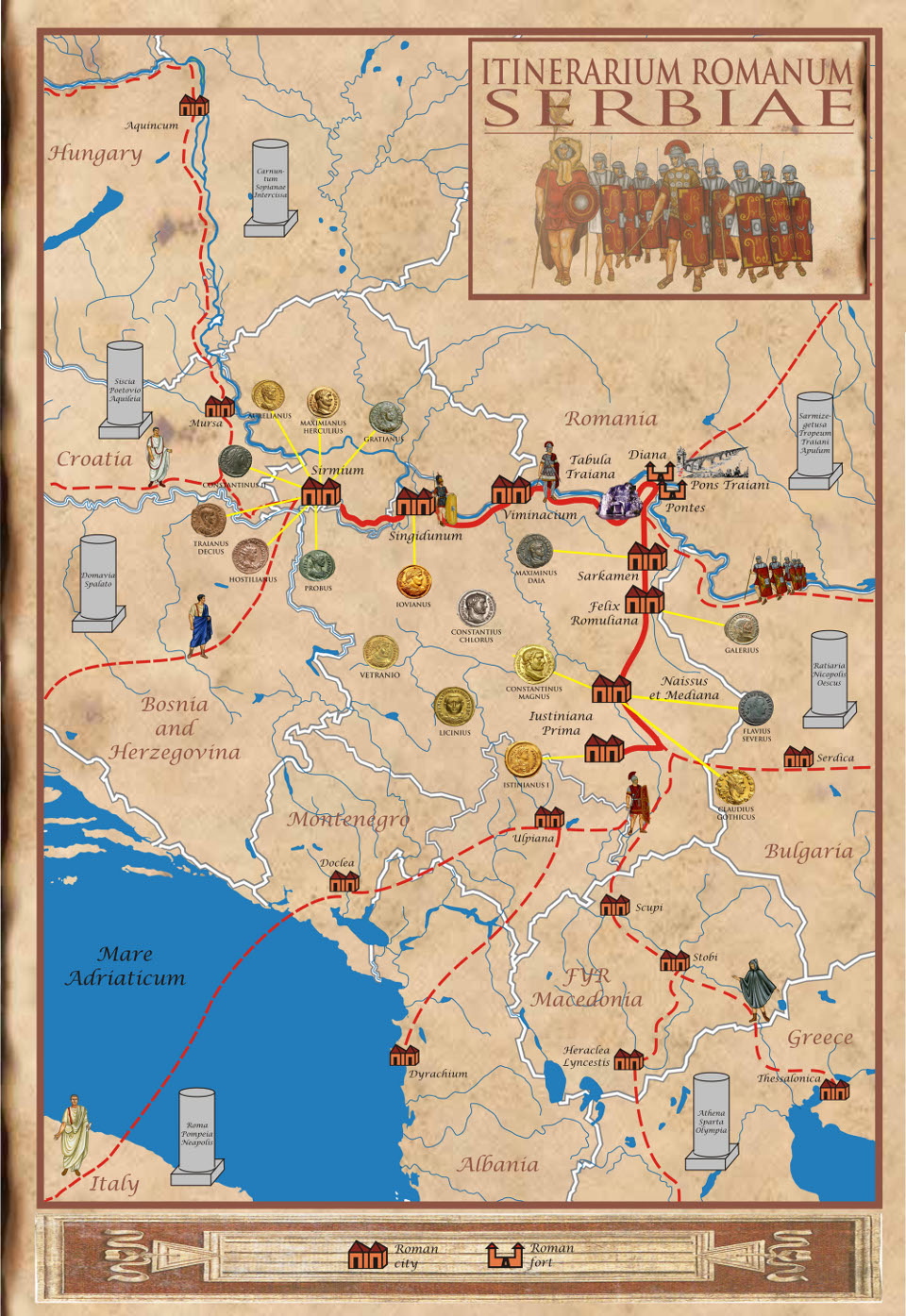Itinerarium Romanum Serbiae
Daleko od Rima, na nepredvidivom Dunavu, Rimsko carstvo je ustanovilo svoju granicu – limes. Ova utvrđena granica prostirala se od severne Engleske, od granice sa Škotskom preko Nemačke, Austrije, Mađarske, Srbije, Rumunije i Bugarske do Iraka i Irana, uključujući prednju Aziju sa Turskom i ceo submediteranski deo severne Afrike. Veoma značajna je činjenica da su najelitnije rimske trupe u kasnoj antici regrutovane upravo sa ovih naših prostora. Za vojskom, koja je razgranatom putnom mrežom lako stizala iz udaljenih azijskih i afričkih provincija u najudaljenije delove zapadnog dela Rimskog carstva, pošli su i trgovci i zanatlije – tako su brzo nikli gradovi duž svih važnih komunikacija. Gornja Mezija i Donja Panonija, od sredine III veka, za nešto manje od dve stotine godina su od marginalnih pograničnih provincija postale središte zbivanja u Carstvu. Područje Ilirika i njegove elitne trupe iznedrile su osamnaest imperatora koji će vladati Carstvom u vreme najdubljih kriza. Od druge polovine III veka, pa do sredine IV veka kada je Rimsko carstvo u krizi, ovaj prostor izuzetno dobija na značaju. Najnovija arheološka istraživanja na Viminacijumu (Viminacium), glavnom gradu rimske provincije Gornje Mezije – u kasnoj antici Prve Mezije – ukazuju na to da je ovaj veliki grad bio značajna tranziciona tačka između Zapada i Istoka. Bogatstvo materijala nađenog poslednjih godina na Viminacijumu to potvrđuje, i to naročito nalaza iz prvih decenija IV veka. Rimski imperatori rođeni u bogatim gradovima na limesu ili u vrletima zaleđa, promeniće lice sveta kakav je do tada postojao. Imajući u vidu da osamnaest rimskih imperatora rođenih na teritoriji današnje Srbije predstavljaju petinu ukupnog broja svih rimskih careva i najveći broj rimskih imperatora rođenih van Italije, pod rukovodstvom Arheološkog instituta i dr Miomira Koraća, pokrenut je projekat Itinerarium Romanum Serbiae ili Putevima rimskih imperatora po Srbiji. Osnovna ideja projekta je da se sva carska mesta na teritoriji Srbije, koja su od nemerljivog istorijskog i arheološkog značaja povežu u jednu celinu, kakva je postojala dok je Rimsko carstvo bilo na obalama Dunava. Projekat ima panevropski značaj i cilj da se poveže sa gradovima u drugim provincijama na teritoriji Rimskog carstva, gde su rođeni ili obitavali rimski imperatori. Njegov poseban značaj je i u povezivanju i oživljavanju puteva u Rimskom carstvu (na primer Via militaris), a naročito duž utvrđene rimske granice – limesa. Putevi rimskih imperatora treba da povežu sva mesta s bogatim antičkim nasleđem u kulturnu rutu dugačku više od 600 kilometara i iskoristi je za razvoj kulturnog turizma. To je nasleđe ne samo Srbije nego cele Evrope i sveta.
PROJECT SUMMARY:
Project Leader
Miomir Korać, PhD
Institutions / project holders:
Archaeological Institute Belgrade
Centre for New Technologies Viminacium
Institutions / cooperating in program
Ministry of Culture – Republic of Serbia
Ministry of Science – Republic of Serbia
Ministry of Tourism – Republic of Serbia
Ministry of Economy and Regional Development – Republic of Serbia
Ministry of Capital Investments – Republic of Serbia
National Investment Project (NIP)
Institute for protection of cultural Monuments of Republic of Serbia
Regional Institute for protection of cultural Monuments Sremska Mitrovica
Regional Institute for protection of cultural Monuments Niš
Institute for protection of cultural Monuments – City of Belgrade
National Museum Belgrade
Archaeological Museum Đerdap
Lepenski Vir Museum
Museum of Srem – Sremska Mitrovica
Belgrade City Museum
Regional Museum in Zaječar
Regional Museum in Niš
Regional Museum in Leskovac
IDEA OF THE PROJECT
Project Itinerarium Romanum Serbiae is the international project based on multiple levels and with multiple goals:
It is planned as a combined project of science and culture using latest methods in research
It is intended to revive and connect ancient Roman Roads, of which many correspond to present day communications
It is planned to build on this route a network of 100 boarding houses, replicas of Roman villas (villa rustica), resting places (mutatio) and motels (mansio)
The aim is to employ local population according to a system of family manufacture. In boarding houses would be employed 800 man and women. Four times more people (3000-4000) are planned to enroll in business supporting those boarding houses in the form of catering, souvenir production and so on. These boarding houses would be positioned on the route on distance of 5-10 km. Their position would be in natural environment, in forests, crop fields and pastures, mostly along rivers Sava, Danube, Morava and Timok.
FOCAL POINTS OF THE PROJECT:
Economically sustainable project – main problem are generally initial investments
Thematically linking of all similar Archaeological Sites in country and abroad
Development of economy and tourism through
Production of Souvenirs
Employing of new workers on sites and archaeological parks
100 boarding houses, replicas of Roman villas, on route in order to provide accommodation for visitors
Building and development of local infrastructure
Improving of standard of local communities:
Special attention focused on economical development of poor regions (southern and Eastern Serbia)
Development of local small industry and family workshops
Reviving of old craftsmanship which ceased due to economic crises
Rising standard of local communities due to higher traffic of people and goods
Development of Archaeological tourism on national level
Promotion of National treasures and improvement of reputation of Republic of Serbia
WAYS OF PROMOTION:
Through popular web sites and multimedia presentation
Through popular publications
Through re-enactment events (roman fests, legionary parades, chariot races, gladiatorial combats etc.)
Through popular music concerts
Rising conscience of local communities about Serbian cultural treasures and its international importance
Protection of cultural heritage through its use in economical projects
Initial infrastructure for multimedia presentation and surveillance is already made. Wireless internet with security cameras is fully functional. These cameras can be also used in remote presentation of sites by web visitors.
PROJECT BACKGROUND:
Serbia is homeland of 18 Roman emperors among who are Constantine I and Justinian I. This is the largest number of emperors born in some province out of Italy. On the territory of Serbia we have imperial city (Sirmium), provincial capitals (Sirmium and Viminacium), imperial residences and villas (Felix Romuliana, Šarkamen, Mediana and Iustiniana Prima), combined with fortified frontier with many cities, legionary and auxiliary forts (Singidunum, Diana, Pontes, Naissus). These sites represent enormous heritage from antiquity. All previously mentioned makes Serbia one of the central points in Roman Empire for centuries.
Global problem related to development of route is either outdated or not existing infrastructure. Roads in some sections are bad and damaged. There are no boarding houses, motels, hotels or restaurants. All facilities planned to accommodate and improve tourist visit do not exist.
On territory which is covered by route exist 5,669 beds. Most of these beds are in 20 hotels 60.58% (3.362) which belong to low categories of accommodation. Road and tourist signalization is missing on almost all parts of the route, especially on those which are remote of highways.
Sites are not protected against looters and do not have permanent guard service except Viminacium.
Major problem within sites themselves is missing of educated guides. They are either missing adequate knowledge of foreign languages or missing information about history and archaeology. Educating them according to all European standards is one of priorities of the project.
Roman culture as paneuropean heritage and first “European Union” is widely recognized and attracts tourists where ever it is presented. Promotion of Roman heritage has no burden like national tourism, which could discourage visitors because of recent political events.
Goal of connecting many valuable archaeological sites into one connected route will bust number of visitors to those sites which are not on regular tourist routes or along major highways.
Further development of the idea is to promote and provide information about complete roman heritage through information presented about all sites on every site. In that way even visitors who cannot see all sites can learn everything. Sites included in this route are not competing but working together with same and unique goal.
Since archaeological sites were never observed as one single product they were not included in one presentation project. This changed and so far all sites are developing in equal manner and under single international standard for presentation.
MODEL FOR DEVELOPMENT OF THE ARCHAEOLOGICAL SITES
Project is classified as a project of National interest for preservation and protection of cultural heritage. The best way to preserve any archaeological site is to revive it and make a tourist attraction of it. Bringing people will protect it from many threats which include looting or illegal building on the area of site. This will also raise awareness of local population about great treasure they poses and motivate them for further protection in order to exploit it. Local population not interested in protection of their own heritage is one of the greatest threats. Enormous possibilities and ways to exploit cultural heritage makes it one of potentially most payable projects.
Cultural heritage can be used as a base for economic and regional development. We have chosen to use an economic model that already proved to be functional, prosperous and financially sustainable. That is the model of Viminacium, Roman city and military camp.
In only six years we have created archaeological park that only during last year over 55.000 tourists visited by land and additional 10.000 came via river cruises along Danube. The fact is that more than 600 tourist river cruisers pass along Danube with more than 200.000 visitors aboard. This model of presentation of archaeological sites was already promoted on all major tourist fairs in Milan, Berlin, London, Cologne, Pestum and so on. Presentation and rapid development of this site is a basic development model that is applied in general planning for all other sites. Examples of Pompeii in Italy and Viminacium in Serbia are the best examples of prosperous archaeological sites that attract large numbers of visitors.
FURTHER DEVELOPMENT OF THE PROJECT
Project is planned not as local cultural route, but as international project linking all cultural projects and routes related to Roman archaeology and Roman emperors. That plan is already emphasized on main project map where we marked the routes to closest and most important related roman cities. Project is nevertheless open for all international cooperation. Roman Empire was predecessor of European Union and modern borders do not correspond to Roman provinces. Because of that Projects related to Roman age should not be observed through present day national filters which could narrow presentation and vision of the Roman Empire and its Emperors. Full presentation of Roman heritage could be achieved only through international cooperation what many exhibitions so far proved. Thematic exhibitions as “Constantine the Great” in Trier, “Hadrian empire and conflict” in London, “Rome and Barbarians” in Venice and so on, prove that international vision of the empire is essential to understanding our past.
Roman cities as Aquincum, Sopianae, Intercissa, Mursa, Siscia, Spalato, Pola, Emona, Poetovio, Nicopolis, Osecus, Ratiaria, Sarmizegetusa, Apulum, Doclea. Scupi, Heraclea, Stobi, Athena, Sparta, Olympia, Pompeii, Neapolis and finally Rome are something what makes this project unfinished if not connected in one major cultural route. Only project planned in Roman dimensions can achieve full presentation of cultural Heritage. Finally connecting our sites to cities as Mediolanum, Trier and Nicomedia can fully present Tetrarchial Age of Rome and beginnings of domination of Christianity.


